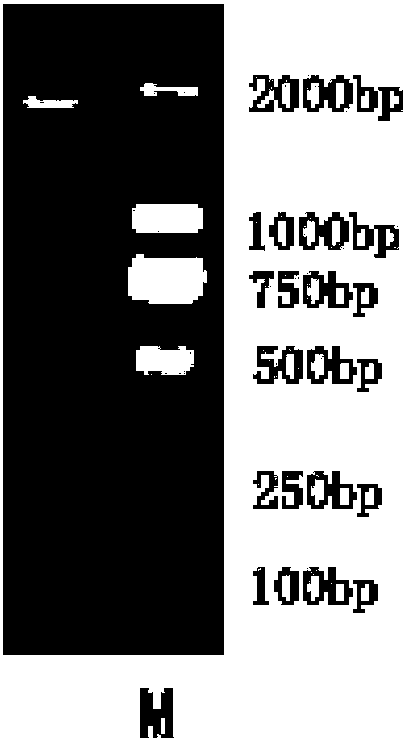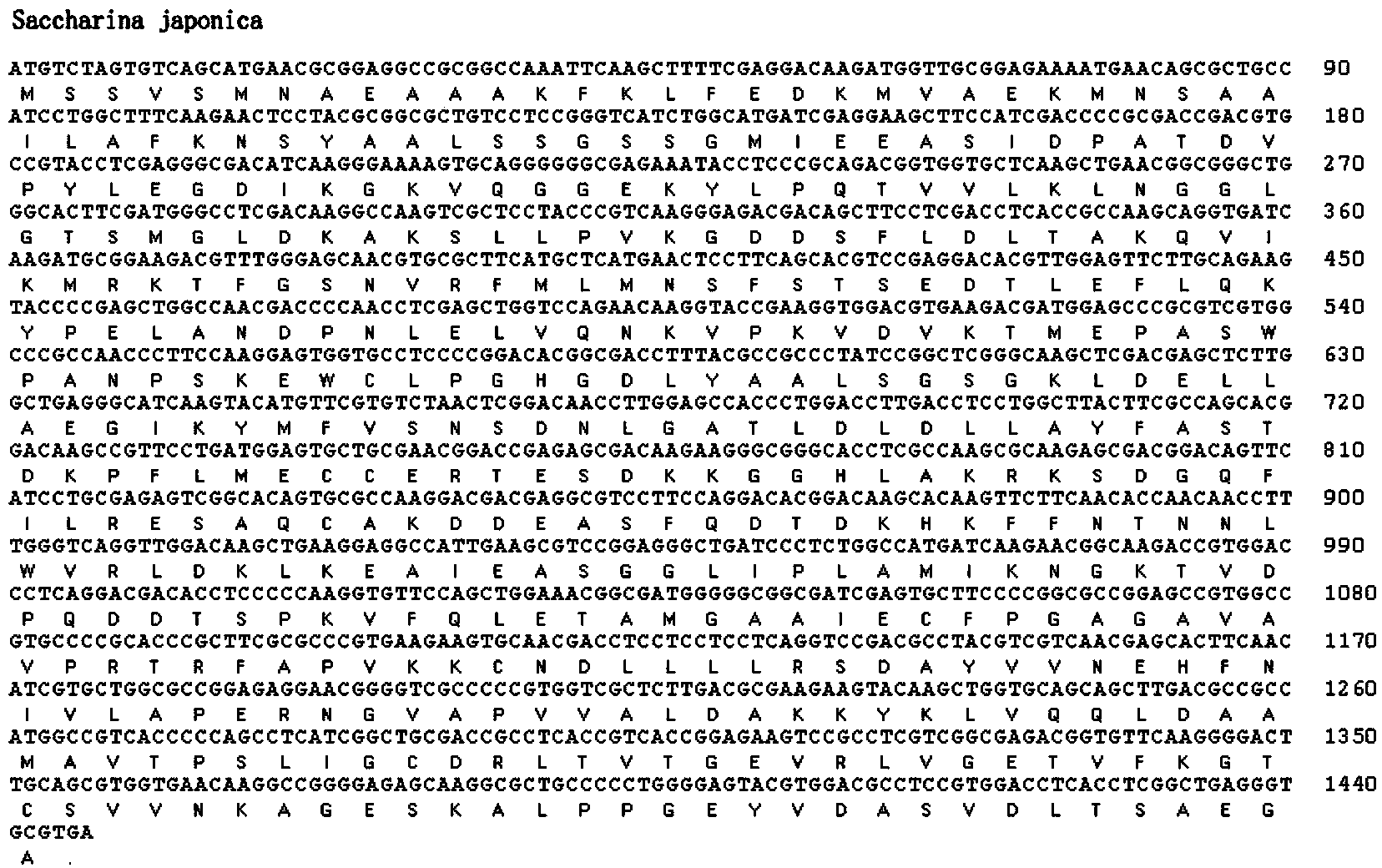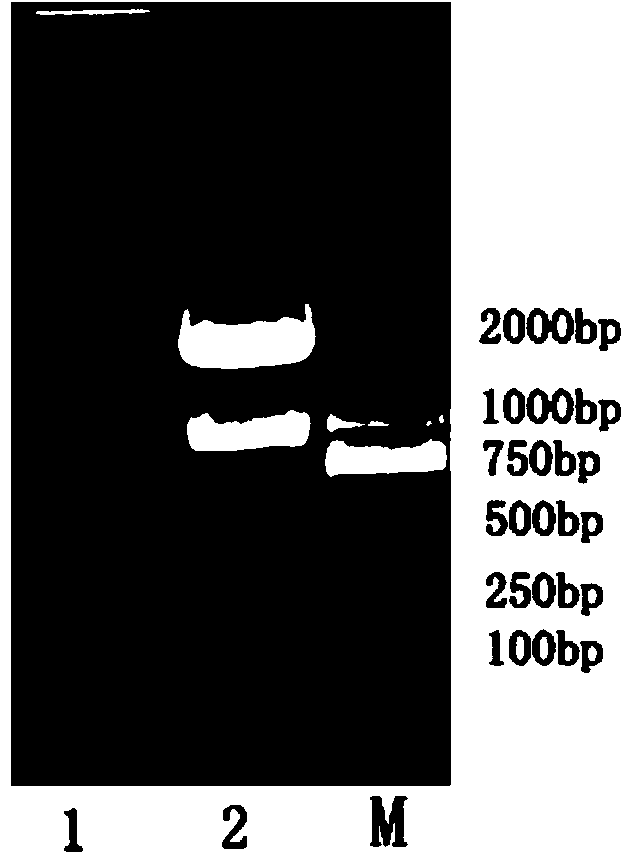Kelp uridine diphosphate (UDP)-glucose pyrophosphorylase (UGPase) gene
A phosphorylase gene, uridine diphosphate technology, applied in genetic engineering, plant gene improvement, hydrolase and other directions, can solve the problems of lack of clones and unconfirmed functions.
- Summary
- Abstract
- Description
- Claims
- Application Information
AI Technical Summary
Problems solved by technology
Method used
Image
Examples
Embodiment 1
[0026] Example 1: Cloning and analysis of the full-length coding region of the gene
[0027] The kelp was collected from Rongcheng City, Shandong Province in July 2011. Laminaria female gametophyte total RNA was extracted by Trizol method, using TAKARA PrimeScript II 1 stThe Strand cDNA Synthesis kit uses the first-strand cDNA reverse-transcribed from the total RNA of Laminaria gametophytes as a template, and uses Touchdown PCR technology to amplify the full-length CDS sequence of the Laminaria SjUGP gene. The amplification primers include 2 sets (5′-CAGCGGATCCATGTCTAGTGTCAGCATGAACGCGG- 3′ and 5′-ATTAGCGGCCGCCGCACCCTCAGCCGA-3′; 5′-CAGCGGATCCATGTCTAGTGTCAGCATGAACGCGG-3′ and 5′-ATTAGCGGCCGCCGCACCCTCAGCCGA-3′). The PCR amplification program was: 94°C for 3min; 94°C for 30s, 60°C for 30s, 72°C for 2min, 15 cycles, and the annealing temperature was lowered by 1°C in each cycle; 94°C for 30s, 45°C for 30s, 72°C for 2min, 20 cycles ; 72°C for 10 min. After the PCR products were de...
Embodiment 2
[0028] Example 2: Preparation and Analysis of SjUGP Encoded Protein
[0029] After the Kelp SjUGP PCR product was detected by 1% agarose gel electrophoresis, the target band was excised under ultraviolet light, recovered from the agarose gel, and the recovered product SjUGP and pET32a plasmid were digested with EcoRI and NotI, and placed in a metal bath at 37°C After 3-4 hours, it was detected by 1% agarose gel electrophoresis and recovered using an agarose gel recovery kit. The target fragment SjUGP was ligated with the plasmid pET32a, overnight at 16°C, and the constructed recombinant plasmid was named pET32a-SjUGP.
[0030] Transform the recombinant plasmid into Escherichia coli expression strain BL21, pick BL21 positive clones, shake the bacteria and save the strain. PCR detection of recombinants. PCR products were detected by 1% agarose gel electrophoresis and imaged by an automatic gel image analyzer. Pick and sequence the correct clones for electrophoresis detection ...
Embodiment 3
[0032] Example 3: Functional verification of SjUGP encoded protein
[0033] Determination of UGP enzyme activity: the reaction system is as follows: 100mM 1×PBS, 0.85mM UDPG, 0.5mM PPi, 5mM Mgcl2, 0.3mM NADP, 5unit PGM, 5unit GDH and an appropriate amount of recombinant SjUGP protein prepared in Example 2. The total reaction system is 1 mL, the substrate M-6-P was added to initiate the reaction. Mix the above substrate-removing system and incubate at the corresponding temperature for 2 minutes to initiate the reaction. Use the corresponding buffer as a blank control and measure the changes in the absorbance at 340 nm at 0 min, 6 min and 12 min. 4 parallel samples. After testing, the enzyme activity is 373.38U / g, the Km to UDPG is 4.33umol, the optimum reaction temperature is 37°C, and the optimum pH is 8.0. The enzyme is a high temperature enzyme, basic protein; Mg 2+ , Zn 2+ , Mn 2+ and Ca 2+ Can promote enzyme activity, Pb 2+ 、Cu 2+ inhibit its activity.
[0034] At...
PUM
 Login to View More
Login to View More Abstract
Description
Claims
Application Information
 Login to View More
Login to View More - R&D
- Intellectual Property
- Life Sciences
- Materials
- Tech Scout
- Unparalleled Data Quality
- Higher Quality Content
- 60% Fewer Hallucinations
Browse by: Latest US Patents, China's latest patents, Technical Efficacy Thesaurus, Application Domain, Technology Topic, Popular Technical Reports.
© 2025 PatSnap. All rights reserved.Legal|Privacy policy|Modern Slavery Act Transparency Statement|Sitemap|About US| Contact US: help@patsnap.com



